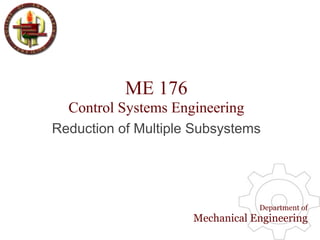Lecture 10 ME 176 Reduction Of Multiple Su
- 1. ME 176 Control Systems Engineering Reduction of Multiple Subsystems Department of Mechanical Engineering
- 2. Signal Flow Graphs: Elements: Nodes Branches Branches = Systems Nodes = Signals Arrow = Direction of signal flow Transfer function written adjacent to line. Department of Mechanical Engineering
- 3. Signal Flow Graphs: Each signal is sum of signals flowing into that node. Department of Mechanical Engineering
- 4. Signal Flow Graphs: Cascade Form Represent Singals as Nodes Interconnect the nodes with system branches Department of Mechanical Engineering
- 5. Signal Flow Graphs: Parallel Form Department of Mechanical Engineering
- 6. Signal Flow Graphs: Feeddback Form Department of Mechanical Engineering
- 7. Signal Flow Graphs: Department of Mechanical Engineering
- 8. Signal Flow Graphs: Department of Mechanical Engineering
- 9. Signal Flow Graphs: Department of Mechanical Engineering
- 10. Mason's Rule: Definition Loop Gain: The product of branch gains found by traversing a path that starts at a node and ends at the same node, following the direction of the signal flow, without passing through the node more than once. Department of Mechanical Engineering
- 11. Mason's Rule: Definition Forward Path Gain: The product of gains found by traversing a path from the input node to the output node of the signal-flow graph in the direction of signal flow. . Department of Mechanical Engineering
- 12. Mason's Rule: Definition Nontouching Loops: Loops that do not have any nodes in common Department of Mechanical Engineering
- 13. Mason's Rule: Definition Nontouching-loop Gain: The product of loop gains from nontouching loops taken two, three, four, or more at a time. Department of Mechanical Engineering
- 14. Mason's Rule: Department of Mechanical Engineering
- 15. Mason's Rule: Example Step 1 : Identify the forwardpath gains: Department of Mechanical Engineering
- 16. Mason's Rule: Example Step 2 : Identify the loop gains: Department of Mechanical Engineering
- 17. Mason's Rule: Example Step 3 : Identify the loop gains (2 @ a time): Department of Mechanical Engineering
- 18. Mason's Rule: Example Step 4 : Identify the loop gains (3 @ a time): Department of Mechanical Engineering
- 19. Mason's Rule: Example Step 5 : Using Mason's rule - evaluate for : Department of Mechanical Engineering
- 20. Mason's Rule: Example Step 5 : Using Mason's rule - evaluate for : Department of Mechanical Engineering
- 21. Mason's Rule: Example Step 5 : Using Mason's rule - evaluate for : Department of Mechanical Engineering
- 22. Laboratory : Material for the laboratory sessions that come after this lecture can be viewed from the class site at: http://sites.google.com/a/vinta.com/me-176/ Please make sure to read the directions at the bottom of the page for instructions on how to submit the laboratory working sessions. Department of Mechanical Engineering

